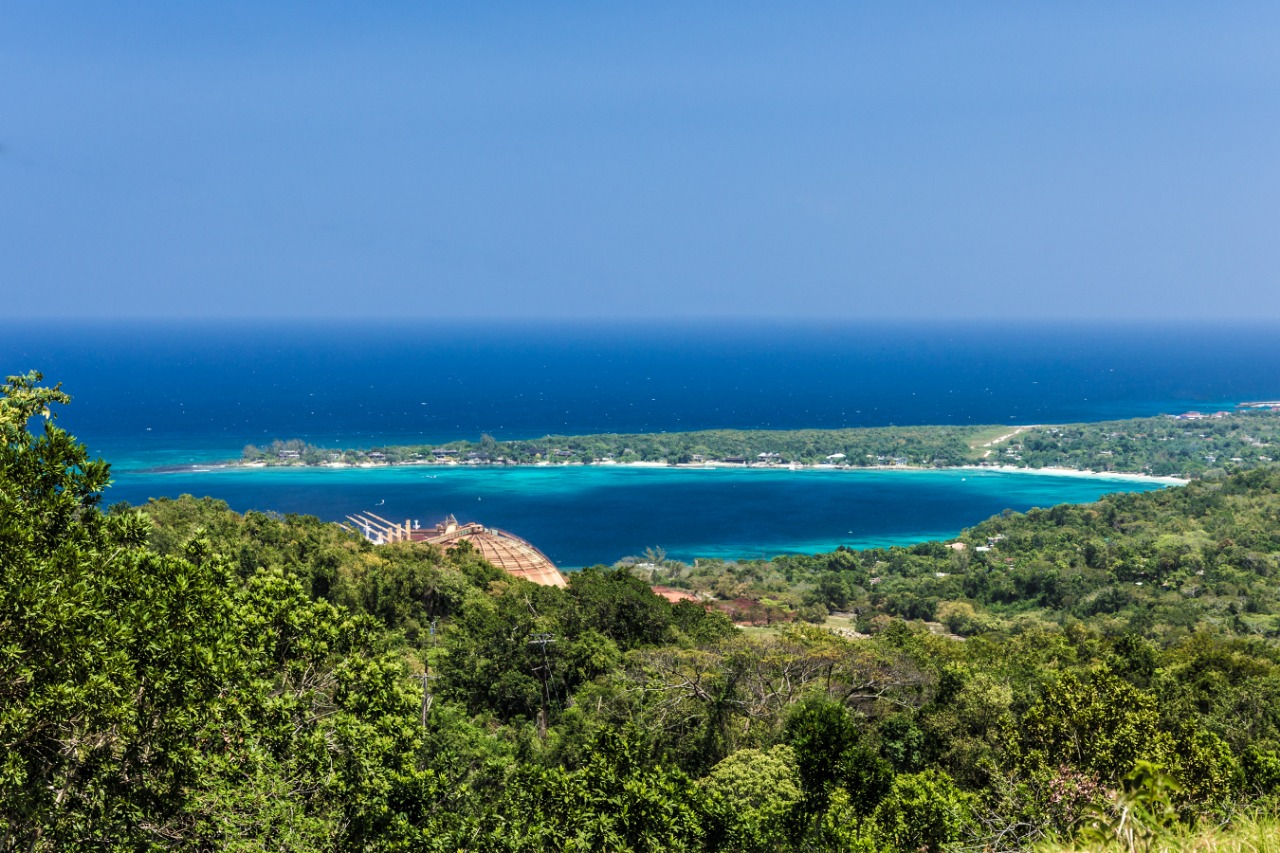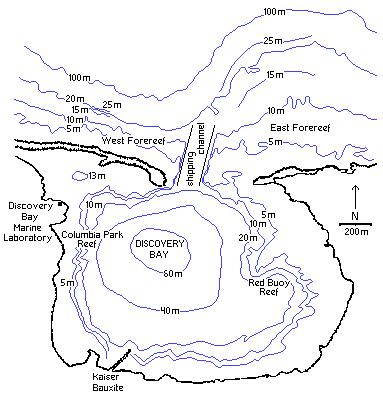By Erica Downer,
Discovery bay, St. Ann, is an almost perfect horseshoe bay, about a mile across each way, with famously crystal clear, intensely blue water, and a fringing reef, through which a narrow channel was cut for the ore freighters which call about once a week.
As you will see from the topo map, water exchange with the open sea is likely to be somewhat inhibited.
In 2009, it was made a legal Fish and Marine Sanctuary and since then local fishermen have observed a healthy recovery of fish stocks meaning that their catch just outside the bay is very much improved.
I myself bought a very small cottage on the eastern shore in 1985.
In about 2015, I am told, Guardsman Hospitality signed a 25 year lease (with an option to renew for another 25 years) with the Government (the Nepa site actually says Kaiser) for about ten acres of what is known as Puerto Seco Beach, probably among the best two or three beaches in Jamaica and proceeded to develop it as a Beach Club which has actually been done very well indeed, however we, the community, did not know of plans to create a captive dolphin facility until the sign went up in March, and even then many did not know as the sign was behind a chain link fence and not in a very prominent position. And it refers to permission for a dolphin facility in “Ocho Rios Bay”.
Applications like these are made to the National Environment and Planning Agency (NEPA) who make recommendations to the National Resources Conservation Authority (NRCA) who then issue the approval.
In this process NEPA are encouraged but not required by law to hold a public meeting for discussion and although the footprint is small, because of the special circumstances of possibly limited circulation in the Bay and that it is a marine sanctuary they were obliged to make some pretty careful studies.
They asked Dr. Mona Webber, Director of the UWI Marine Lab in Discovery Bay for an opinion; her response in July was entirely negative and she has maintained that opinion ever since, without, so far as I am aware, any acknowledgement. They asked the Alloa Discovery Bay Fisherman’s Association for an opinion and their response was also negative and responded to by NEPA with a two-word e mail “objection noted”.

DFT- Dolphin Cove
*** Local Caption *** A trainer takes a dolphin through its paces at the flagship marine park owned by Dolphin Cove Limited in Ocho Rios.
I am told they asked Fisheries for an opinion, I have not seen this request nor a response. In May there was a demonstration against the dolphin facility by the Discovery Bay Community Development Committee which was televised and reported in the press. Neither of their letters of objection were responded to.
In August the Jamaica Environmental Trust (JET) wrote a strong letter of objection which was not responded to. In November when I found out about the facility (I had been away in the summer hence did not see any of the publicity) I wrote the Chairman of NEPA, the NRCA and the Chair of the NEPA Advisory Board and received no response. I wrote them all again last week.
The approval was granted in October and I am in possession of a copy of the application and approval documents, obtained by JET under the Access to Information Act. They show that ONLY a benthic study was carried out, by one named Marine Biologist, to assess the small footprint area.
NO water samples were taken to establish a baseline measurement against future samples, no current studies (a very old water current study cannot be found), no benthic cores, no in depth evaluation of fish stati, no environmental impact assessment. I confirmed this with a conversation with the named Marine Biologist.
An attempt has been made in the application to show some impact assessment but it is not location-specific. The Marine Lab is currently doing some water sampling but need at least three more months for it to be properly complete and are not equipped at this time to do current studies. It should be noted that in these documents, Dolphin Cove are named as the entity who will take water samples going forward.
Discovery Bay is already ecologically stressed for a number of reasons. The impact of nutrients from excreta will grow algae which may in turn kill sea grass beds and corals. By the time water sampling shows increased nutrients the process has begun and is very difficult to reverse. We do not know how bad it will be, but expert opinion is that it will indeed be damaging; fish will leave when their food source dwindles and we may have a dead or dying Bay.
In addition the prospect of swimming in proximity to the pen/s is unpalatable since up to eight dolphins will produce up to eighty pounds of liquid excreta per day, some of which floats. The current that we know from experience, will carry this first, right along Peach Beach, the Fisherman’s beach and our homes’ waterfront.
We see no need for a fifth captive Dolphin Facility on our north coast; we cannot understand why Jamaica, in the forefront by banning plastics, and showing such a fine sense of responsibility in preserving Goat Island and Cockpit Country, should wish to participate in an activity gaining disfavor all over the world.
Fourteen countries have now banned keeping whales and dolphins in captivity including Bolivia, Chile, Costa Rica, Croatia, Cyprus, Greece, Hungary, Nicaragua, India, Slovenia and Switzerland. And now Canada, of course. California, New York, South Carolina and Hawaii are either passing bills or simply don’t license them. Florida announced a bill this week, making illegal the captivity and breeding in captivity of Orcas, a larger dolphin. Mexico City have announced a ban, effective February 2019.
France declared a nation-wide ban in 2017 but allowed operators three years to close down. Spain is close to going that way, Barcelona has banned all new dolphinaria and are closing old ones. A few countries have standards so strict that it is nearly impossible to keep cetaceans in captivity, including Brazil, Luxembourg, Nicaragua, Norway, and the United Kingdom, where the last dolphinarium was closed in 1993. Cruise ship companies and resorts are coming under increased pressure to stop offering captive dolphin programmes. The price of a trained dolphin (US$30,000 to 250,000) still helps to drive the trade, as does the very high admission cost (anywhere from US$75 to $150 per person); this is a very profitable business with low capital requirements and a huge return.
And the REASON that so many countries are banning dolphinariums is the sheer cruel brutality of it all. Many dolphin are killed in these capture drives, or during transportation after, rib cages unaccustomed to body weight in the air, are crushed. I read a report that stated that 53% of dolphins that survive all this, die within three months. At SeaWorld in the seven years between 1996 and 2003, no less than 77 cetaceans in their care, died. And one trainer. Twenty-two thousand dolphin are slaughtered every year in Japan alone, some for food; the meat is heavily tainted with mercury from the waters around Japan and is less popular now but is often simply labelled as whale meat, fishermen are apparently eager to be rid of competition for “their” fish (according to one fisherman who “turned” and has become something of a celebrity), but the prime young females are kept for sale, so the drives continue. International Trade is governed by CITES but smuggling happens, because of the value of the commodity. Japan simply ignores CITES anyway. Some operators, usually illegally, take dolphins from their local coastal waters.
It is no use to say that captive dolphins can be used for conservation or educational purposes. The very captivity propagates the dreadful trade. And children (or adults) cannot be educated about the life of wild dolphins while the dolphins are restrained, as dolphins in captivity exhibit profoundly abnormal behavior. There are 3,000 captive dolphins world-wide today, and since it all began with “Flipper” in ALL that time only 80 young have ever been bred successfully and they remain wild animals, instincts honed over 12 to 15 million years cannot be eliminated in one or two generations. Nor is there selective breeding as was the case in many domesticated animals; often they are simply bred to another captive dolphin, often closely related.
Cetaceans are the most intelligent creatures in the sea, their brains are larger than ours and they are second only to us is brain/body weight ratio; they form lifetime bonds within their pods, or families, communicate with other family members in language so complex that scientists cannot yet decipher it, but cannot communicate with other families, the older teach the younger – what gives us the right to destroy this? Dolphins can swim to Cuba to hunt, 80% of their time is spent diving deep, up to a thousand feet. Even the inshore sub-species swims probably 40 miles a day. What right have we to keep them in 10 foot deep pens, sunburned and often hungry since food is withheld in the training process? There are facilities now that undertake the very time consuming and necessarily expensive process of rehabilitation.
Dolphins are naturally gentle and curious, and many instances have been recorded of their saving human lives at sea or leading ships through passages to safety. But in captivity, they have been known to become aggressive, particularly males. There is notorious under-reporting of injury to participants in interactive programmes, with some out-of-court settlements. In addition, there are a number of diseases that are passed from dolphin to man, and man to dolphin including influenza, salmonella, brucellosis, staph infections, tuberculosis and fungal infections.
Bottlenose dolphin populations throughout the world are not yet endangered, but they are declining. The Yangtze River Dolphin is already extinct. The last one, Qi Qi died in the Wuhan dolphinarium in 2002. There are as few as 30 left of the Vaquita Porpoise, the latest scientific estimate is six; it will be extinct in less than two years; it is found in only one place in the world, the northern Gulf of California. Fishermen there are trying to catch the Toatoba fish for its’ swim bladder to satisfy demand in China for “traditional medicine” but illegal gill nets don’t discriminate and the bladder is worth more than cocaine per ounce on the black market, US$50,000 for a single bladder. There is always a reason.
What of the economic cost of this project? Infrastructure is minimal, employees few, but who is going to attempt to reinstate and restore Discovery Bay, whose cost will it be? It will be vast. Who is going to compensate the fishermen for their lost catches? The approval exempts Dolphin Cove from being required to make good any damages so will that be a cost to government, and therefore to us?
As homeowners we are concerned about our investments, who will come to stay in our houses with such a facility nearby? We, the fishermen, the local community, the scientists, are unanimous in our opposition to this, and the community has presented to the Prime Minister a petition that gathered 15,000 signatures in just 34 days, bettering the requirements of an official OPM petition which needs 15,000 signatures in 40 days to mandate action. I was told that the OPM site was not working hence their choice of change.org. As of today signatures are close to 16,300.
The people of Jamaica neither want nor need this captive dolphin facility in Discovery Bay. The approval MUST be withdrawn or at the very least installation should be delayed by six months to allow for proper testing and impact studies and consultations with stakeholders.






May God help my brothers and sisters of Jamaican. Big BUSINESS just stole the beauty of your beaches for a few dollars more and the locals suffer. Take your waters back and keep it for Jamaicans.
From a Trini friend.
Thanks for the information, very well researched. What’s the next move? Our family has signed the petition.